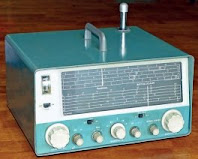Early Adventures in Radio
During my teenage years I used to spend hours scanning the shortwave frequencies on an old Heathkit Mohican CG-1, purchased at a radio rally at Epsom race course. I threw a long wire out the window and over the roof and was listening to enhance the built in telescopic antenna, the results were outstanding. As CB gripped the country in the early 80's I bought myself a "rig" and with the help of a neighbor got online. I won't try to remember what it was or the antenna, but as a teenager it was a lot of fun.
I never recovered the Heathkit radio from my parents house when I left home for the forces so have no idea where it went, but I can guess.
 |
| Heathkit Mohican CG-1 |
I spent 15 years of my life wearing green for a living, and one of the sidelines was being trained as a radio operator with the Clansman line of equipment. This included vehicle loaded radios, various man-packs, pneumatic masts and various types of antenna. We were not trained on the theory of radio, just how to get them working, setting up repeater stations, what to say and how to say it. The main radio I recall lugging around was the Clansman PRC 320 HF, this "manpack" was normally taken off the extremely uncomfortable metal frame and placed inside the backpack. Headset was used by the operator and handset for "Sunray" (whoever was in charge). The radio was squaddie proof, but extremely heavy for it.
 |
| Clansman PRC 320 HF |
We knew that the opposition, across the wall, had recordings of our voices and tracked our movements between units and locations by our voice-print. They did however struggle with the Glaswegian and Gurkha operators, as did the rest of the British Army!!
The Clansman PRC 349 VHF/UHF was section radio for short range communications and way easier to carry. The radio was worn over a shoulder and used a throat mic and single ear headphone strapped across the head. The coverage was no better than one of today's Baofeng hand held radios but again was Squaddie proof, designed to thrown about, dropped and mistreated in every way possible. It was a good exercise when these were issued, no setting up masts or sitting on an exposed hill in all weathers keeping a repeater company.
During these years I continued to listen in to shortwave radio using an Sony ICF-SW7600, bought to keep me in touch while on a short holiday to Saudi in 1991. The radio had an add-on long wire attachment and tuned really well, leaps ahead of the manual Heathkit radio I had used, which you could never be sure of the exact frequency you receiving on. The Sony also had the ability to handle SSB, making amateur radio chat understandable.
 |
| Sony ICF-SW7600 |
Back into civilian life and I continued to listen to shortwave and chasing local US radio stations on AM in the early morning static. I was given a "scanning guide" by a friend, a book GCHQ were not happy about, and I delved deeper into scanning for a while. But life events overtook me in the early 2000's, I needed to concentrate on a real career and so the hobby faded into the distance.
In recent years I was a long distance "ultra" runner, racing once a month or more between 30 and 100 miles. But a nagging pain, bone on bone injury in my hip, put pay to that and I needed to find something more sedate to concentrate my mind on. It was not until I was on the school run one morning and my son asked what the aerials on top of a house were, he was surprised I knew exactly what they were, so was I. At home I did a web search about the licensing and discovered that since covid all had changed and the license was more achievable (and no sign of a morse requirement).
I signed up with Essex Ham distance learning and booked an exam for two weeks after the finish, just to ensure I took the exam and it was fresh in my mind. The course was well designed and catered for all level of starters, including me, and on 18th Dec 2023 I passed my exam. Now the journey begins....
